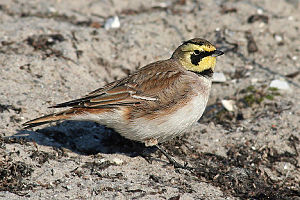Eremophila (animal species)
| Eremophila | ||||||||||||
|---|---|---|---|---|---|---|---|---|---|---|---|---|

|
||||||||||||
| Systematics | ||||||||||||
|
||||||||||||
| Scientific name | ||||||||||||
| Eremophila | ||||||||||||
| F. Boie , 1828 |
Eremophila is a genus ofthe lark family . Among the bird species living today, only two species, namely the ear lark and the horned lark , belong to this genus. The generic name is derived from ancient Greek: Eremos means desert and tolove phileo . According to the generic name, both species inhabit tundras, semi-deserts, deserts and high steppes. The range of the two species is the northern hemisphere. The eared lark is the only species of lark found in South and North America.
The stock situation of both types is from the IUCN with unchallenged ( least concern classified).
features
The species of the genus Eremophila are characterized by paired spring squirrels on the apex. The head markings are black and yellow to black and white. The ear lark, which occurs in numerous subspecies, has both head drawings. The goiter is black in both species.
The beak is slightly higher at the beak base than in larks of the genus Alauda . The nostrils are covered in both species, the rear claw is only slightly curved and only slightly elongated. The hand wings 7, 8 and 9 form the wing tip, the hand wing 10, on the other hand, is almost invisible. A distinguishing feature to the species of the genus Alauda is the distance from the longest arm swing to the wing tip. It is larger than the run length in both species, while it is smaller in the species of the genus Alauda .
Distribution area
The range of the ear lark is very large. As a breeding bird widespread in the Holarctic , the species occurs from the Atlas Mountains of Morocco to North and South America. She is a regular winter visitor to the coasts of Central Europe . It is a very common bird in North America. In terms of its spread, it has benefited greatly from deforestation that began in the milder west and east of North America towards the end of the 19th century. This deforestation has led to a significant increase in the population of this species.
The distribution area of the horned lark is significantly smaller than that of the eared lark. It occurs in the Western Sahara, in the south and northeast of Morocco, in the north of Algeria, in Tunisia, in the north of Libya and Egypt and in the north of the Arabian Peninsula to the east of Syria and the west of Iraq.
species
The following recent species are included in the genus Eremophila :
- Horned Lark ( Eremophila bilopha )
- Ear lark ( Eremophila alpestris )
literature
- Jonathan Alderfer (Ed.): Complete Birds of North America , National Geographic, Washington DC 2006, ISBN 0-7922-4175-4 .
- Rudolf Pätzold: The larks of the world . Westarp Sciences, Magdeburg 1994, ISBN 3-89432-422-8 .
Single receipts
- ↑ James A Jobling: The Helm Dictionary of Scientific Bird Names. Christopher Helm, London 2010, ISBN 978-1-4081-2501-4 . P. 148
- ↑ Pätzold: The larks of the world . P. 216 and p. 220.
- ↑ a b c Alderfer (ed.): Complete Birds of North America . P. 431
- ↑ Eremophila bilopha in the IUCN Red List of Threatened Species 2016.1. Posted by: BirdLife International, 2016. Retrieved December 29, 2016.
- ↑ Eremophila alpestris in the IUCN Red List of Threatened Species 2016.1. Posted by: BirdLife International, 2017. Retrieved January 1, 2017.
- ↑ Nicators, reedling & larks "IOC World Bird List .

